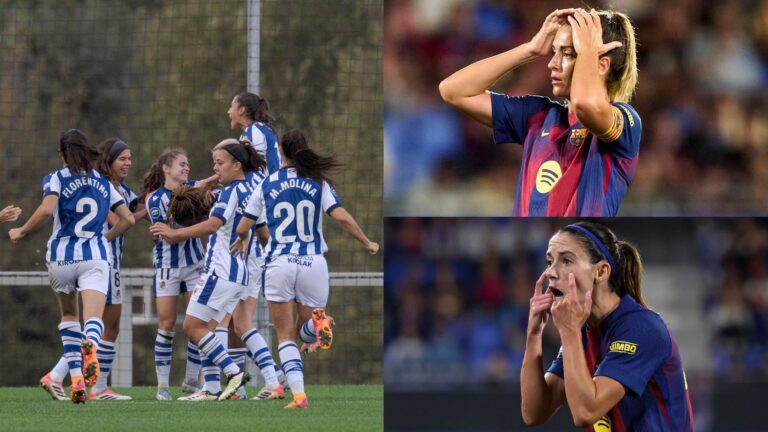Essential Tactics for USWNT’s Showdown with New Zealand
The United States Women’s National Team (USWNT) has wrapped up its series against Portugal, securing retribution following an unexpected initial setback. Now, under the guidance of coach Emma Hayes, the squad turns its attention to a concluding October fixture that introduces fresh hurdles. USWNT New Zealand game keys will be crucial as the team navigates this upcoming test, emphasizing growth and opportunity amid preparations for the 2027 World Cup qualifiers.
Following an intense battle with a determined Portugal team, the USWNT now shifts to confront New Zealand on Wednesday evening in Kansas City. Statistically, New Zealand lacks the capability to match the USWNT’s intensity, meaning the Americans are poised to dominate possession and generate scoring opportunities. Yet, for Hayes and her players, the core objectives remain consistent: fostering team development, securing roster spots, and demonstrating potential. In their recent 3-1 triumph over Portugal, Hayes opted for a lineup averaging just 20.7 years old, signaling a focus on emerging talent to pave the way forward.
This encounter with New Zealand serves as yet another platform for players, especially those still reeling from the prior 2-1 defeat to Portugal. It’s a moment for redemption and further progression, allowing athletes to reinforce their value to the team.
We delve into the five pivotal elements that could shape the USWNT’s performance against New Zealand.






The USWNT offensive lineup has experienced notable shifts this year, with players like Mallory Swanson and Sophia Smith stepping away for maternity leave, joined recently by Lynn Williams. Emma Hayes has noted that U.S. Soccer is actively refining support systems for players around pregnancy to facilitate smoother comebacks.
Currently, forward positions are wide open for competition. Throughout this training camp, various lineups have taken the lead, prompting questions about Hayes’ choices for the next match. Will she introduce a fresh attacking setup or stick with proven combinations?
Experimenting with Forward Options
In the previous outing, the USWNT mixed up their attacking players significantly. Absent Trinity Rodman due to injury, starters included Catarina Macario, Alyssa Thompson, and Michelle Cooper for the initial Portugal game, but only Thompson retained her spot in the follow-up. She was accompanied by Ally Sentnor, Jaedyn Shaw, and Olivia Moultrie up front-with Moultrie shining by netting two goals-while Yazmeen Ryan and Emma Sears also saw action.
From a practical standpoint, Thompson might be due for a rest after her extensive playtime. Otherwise, Hayes has a wealth of choices to evaluate, especially as key players return, helping define the long-term attacking core.
Pivotal Midfield Dynamics for USWNT vs New Zealand
The familiar midfield trio of Lindsey Horan, Sam Coffey, and Rose Lavelle has been a staple, but it’s becoming evident that 18-year-old Lily Yohannes deserves a prominent role. Hayes praised her, stating, “She performs with remarkable maturity. She’s unafraid under pressure, adept at evading markers, distributing wide, and delivering precise passes.”
Integrating Yohannes into the Core
Should Yohannes start, adjustments would be necessary. While long-term decisions can wait, testing a midfield featuring Yohannes could yield insights. She’s paired with Horan and Coffey before, yet never with Lavelle. Perhaps shifting Horan would allow for this experiment.
Ultimately, it’s time to increase Yohannes’ involvement as she matures into a vital asset. Hayes, however, stresses defensive growth, noting, “There’s still much for her to refine defensively. At the elite level, excellence is essential, and that’s true for everyone.”
Goalkeeper Selections in the USWNT Lineup
Deciding the starting goalkeeper remains a focal point.
Rotating Options for the Net
Hayes has distributed starting duties evenly this camp, with Phallon Tullis-Joyce in the first game and Claudia Dickey in the second. This pattern suggests Mandy Freeman could step up next, based on recent trends.
Earlier, Hayes positioned Tullis-Joyce as the leading candidate for the top spot. As the fall schedule progresses, this match will clarify her goalkeeper strategy, potentially opening doors for others.
Fortifying the USWNT Defense Against New Zealand
It’s clear that the USWNT’s backline has struggled lately, allowing goals from set pieces in the first Portugal match and an unchallenged header in the second-especially notable given their spotless record in prior meetings.
Addressing Defensive Flaws
Post-victory, Hayes commented, “We improved our structure and avoided unnecessary pursuits.” Fine-tuning is required, particularly with Naomi Girma sidelined; her potential partners must elevate their game to prevent simple concessions.
Hayes boasts depth in defense, led by veteran Emily Sonnett, who’s featured heavily. The rest lack extensive international experience, with Tara McKeown topping the group at nine caps. Hayes might lean on seasoned club players like McKeown and Emily Sams if they prove reliable. The key directive: maintain concentration to avoid gifted opportunities.
Adapting to New Zealand’s Style in USWNT’s Strategy
Portugal arrived in a slump, marked by heavy defeats to powerhouses like England and Spain, yet they upset the USWNT, proving upsets are possible.
Contrasting Opponent Approaches
New Zealand, ranked 33rd, presents a different challenge compared to Portugal at 23rd, having recently fallen to Mexico in friendlies. Expect a defensive posture from them, employing a deep block.
Given this, Hayes may favor players skilled in confined areas, such as Macario, or those with creative flair like Shaw, who assisted Moultrie’s goal. The midfield could shift to a more offensive bent against a retreating defense, offering valuable experience as the team eyes World Cup qualification.
Who is Lily Yohannes?
Lily Yohannes, a 20-year-old prodigy in women’s soccer, has quickly become a symbol of the future for the US Women’s National Team (USWNT). Born in 2005, she burst onto the scene with her exceptional skills, making her debut for the USWNT at just 18 years old. Her poise, vision, and technical ability on the field have drawn comparisons to legends like Megan Rapinoe, but what sets Yohannes apart is her role in empowering younger players and pushing the team toward defensive innovation. As USWNT prepares for matches against teams like New Zealand, focusing on Yohannes’ development could be key to building a more resilient defense.
In recent years, Yohannes has represented a shift in USWNT strategy, emphasizing youth empowerment and defensive strengthening. Her ability to control the midfield and transition into defensive plays makes her an invaluable asset, especially in high-stakes games. By integrating players like her early, the team can foster long-term growth and adaptability in women’s soccer.
The Importance of Empowering Young Talents in USWNT
Empowering young players like Lily Yohannes isn’t just about giving them playing time-it’s about creating a pipeline for sustained success in USWNT vs. international opponents. Yohannes’ rise highlights how investing in youth can strengthen defense and overall team dynamics. For instance, her experience in European leagues has brought fresh tactics that emphasize quick decision-making and positional awareness, which are crucial for defending against agile teams like New Zealand.
To make this empowerment effective, coaches often focus on mentorship programs and tailored training sessions. Yohannes has benefited from working alongside veterans, learning defensive strategies that blend her natural aggression with smart positioning. This approach not only boosts her confidence but also ensures that USWNT’s defense evolves, incorporating modern soccer techniques like high pressing and zonal marking.
Key Benefits of Youth Empowerment in Defense
- Enhanced Team Cohesion: Younger players like Yohannes bring energy that pairs well with experienced defenders, fostering better communication and reducing errors during matches.
- Adaptability to Opponents: Against teams like New Zealand, who rely on counter-attacks, Yohannes’ quick learning curve allows for real-time adjustments in defensive setups.
- Long-Term USWNT Success: By empowering talents early, the team builds a roster that’s prepared for future tournaments, ensuring defensive strategies remain competitive in women’s soccer.
Five Key Strategies for Strengthening Defense in USWNT vs. New Zealand
When facing New Zealand, known for their disciplined and fast-paced style, USWNT must prioritize defensive strategies that leverage Lily Yohannes’ strengths. These tactics not only empower her but also fortify the team’s backline, making it more robust against counter-attacks and set pieces.
Strategy 1: High Pressing with Midfield Support
High pressing is a cornerstone of modern soccer strategies, and incorporating Yohannes in this setup can disrupt New Zealand’s build-up play. By positioning her higher up the field, USWNT can force turnovers and quickly transition to defense.
- Focus on Quick Transitions: Encourage Yohannes to press aggressively while maintaining defensive shape, using her speed to cover ground and support fullbacks.
- Training Drills: Implement sessions that simulate New Zealand’s passing patterns, helping Yohannes read the game and intercept passes effectively.
- Potential Impact: This strategy could limit New Zealand’s possession, giving USWNT more control and reducing defensive pressure in their own half.
Strategy 2: Zonal Marking and Positional Discipline
Zonal marking helps in strengthening defense by assigning areas rather than individual players, which suits Yohannes’ intelligent positioning. Against New Zealand’s mobile forwards, this keeps the backline organized and minimizes gaps.
- Yohannes’ Role: Position her as a midfield anchor to drop back and fill zones, using her awareness to guide teammates.
- Countering Threats: Practice scenarios where New Zealand exploits wide areas, teaching Yohannes to shift laterally and maintain defensive lines.
- Game-Changing Element: This approach empowers her to make proactive decisions, potentially leading to more interceptions and fewer goals conceded.
Strategy 3: Building from the Back with Confidence
Strengthening defense starts with confident ball distribution from the back, and Yohannes can play a pivotal role in this by linking defense and midfield. This strategy counters New Zealand’s high press by ensuring USWNT doesn’t lose possession early.
- Empowerment Through Possession: Train Yohannes to receive passes under pressure, using her dribbling skills to bypass markers and initiate attacks.
- Defensive Drills: Incorporate exercises that focus on short passes and movement, helping her build chemistry with center-backs.
- Why It Works: For USWNT vs. New Zealand, this could turn defensive plays into counter-opportunities, showcasing Yohannes’ versatility in women’s soccer.
Strategy 4: Set Piece Mastery and Aerial Dominance
Set pieces are often decisive in matches, and empowering Yohannes involves assigning her roles in defending corners and free-kicks against New Zealand’s tall players.
- Specific Tactics: Have her mark key threats in the box, using her jumping ability to contest aerial duels and clear the ball.
- Team Coordination: Use video analysis of past games to prepare, ensuring she communicates effectively with defenders for zonal coverage.
- Long-Term Benefits: This strategy not only strengthens immediate defense but also builds Yohannes’ confidence for future high-level competitions.
Strategy 5: Recovery Runs and Counter-Press Integration
Finally, integrating counter-press tactics allows Yohannes to shine in recovery runs, quickly regaining possession and preventing New Zealand from launching dangerous attacks.
- Speed and Timing: Focus on her ability to sprint back into defensive positions, turning potential counters into defensive wins.
- Integrated Training: Combine this with team drills that simulate end-to-end play, emphasizing her role in seamless transitions.
- Overall Edge: By empowering her in this way, USWNT can maintain a high defensive intensity, making them more formidable in matches like this.
These strategies, when combined, highlight how empowering Lily Yohannes can transform USWNT’s defense, providing a blueprint for success against New Zealand and beyond. By naturally weaving in elements of youth development and tactical innovation, the team can continue to dominate in women’s soccer.









